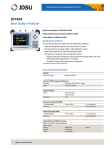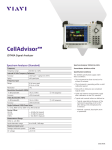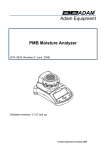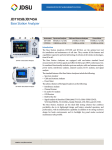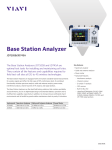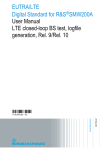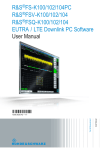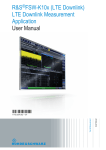Download CellAdvisor JD745A Base Station Analyzer
Transcript
CellAdvisor™ JD745A Base Station Analyzer Spectrum Analyzer (Standard) Spectrum Analyzer: 100 kHz to 4 GHz Frequency Frequency range Cable and Antenna Analyzer: 5 MHz to 4 GHz 100 kHz to 4 GHz Internal 10 MHz Frequency Reference Power Meter: 10 MHz to 4 GHz Accuracy ±0.05 ppm + aging (0 to 50°C) Specification Conditions Aging ±0.5 ppm/year The JD745A specifications apply under these conditions: Range 0 Hz (zero span) 10 Hz to 4 GHz • The instrument has been turned on for at least 15 minutes Resolution 1 Hz • The instrument is operating within a valid calibration period Frequency Span Resolution Bandwidth (RBW) –3 dB bandwidth 1 Hz to 3 MHz Accuracy ±10% (nominal) 1-3-10 sequence Video Bandwidth (VBW) –3 dB bandwidth 1 Hz to 3 MHz Accuracy ±10% (nominal) Single Sideband (SSB) Phase Noise Fc 1 GHz, RBW 10 kHz, VBW 1 kHz, RMS detector Carrier Offset 30 kHz 100 kHz 1 MHz <–90 dBc/Hz (typical) <–95 dBc/Hz (typical) <–102 dBc/Hz (typical) 1-3-10 sequence • Data with no tolerance are considered typical values • Cable and antenna measurements apply after calibration to the OSL standard • Typical and nominal values are defined as: –– Typical: expected performance of the instrument operating at 20 to 30°C after being at this temperature for 15 minutes –– Nominal: a general, descriptive term or parameter Measurement Range DANL to +20 dBm Input attenuator range 0 to 50 dB, 5 dB steps Maximum Input Level Average continuous power +20 dBm DC voltage ±50 V DC www.jdsu.com/nse Data Sheet CellAdvisor JD745A Base Station Analyzer Displayed Average Noise Level (DANL) Spurious 1 Hz RBW, 1 Hz VBW, 50 Ω termination, 0 dB attenuation, RMS detector Inherent residual response Input terminated, 0 dB attenuation, preamplifier off, RBW at 10 kHz, Sweep mode Preamplifier Off 10 MHz to 2.3 GHz >2.3 GHz to 3 GHz >3 GHz to 4 GHz –140 dBm (–146 dBm, typical) –138 dBm (–144 dBm, typical) –135 dBm (–140 dBm, typical) Preamplifier On 10 MHz to 2.3 GHz >2.3 GHz to 3 GHz >3 GHz to 4 GHz –155 dBm (–160 dBm, typical) –153 dBm (–158 dBm, typical) –150 dBm (–156 dBm, typical) Display Range 20 MHz to 3 GHz –90 dBm (nominal) >3 GHz to 4 GHz –85 dBm (nominal) Exceptions <–80 dBm at 311.94 MHz <–84 dBm at 415.92 MHz <–85 dBm at 519.90, 1599.00, and 2497.80 MHz Input-related spurious <–70 dBc (nominal) Dynamic Range 2/3 (TOI-DANL) in 1 Hz RBW >95 dB Log scale and units (10 divisions displayed) 1 to 20 dB/division in 1 dB steps dBm, dBV, dBmV, dBµV Linear scale and units (10 divisions displayed) V, mV, mW, W Range 80 ms to 1000 s 24 µs to 200 s Span = 0 Hz (zero span) Normal, positive peak, sample, negative peak, RMS Accuracy ±2% Span = 0 Hz (zero span) Mode Continuous, single Number of traces 6 Gated Sweep Trace functions Clear/write, maximum hold, minimum hold, capture, load view on/off Trigger source External, video, and GPS Gate length 1 µs to 100 ms Gate delay 0 to 100 ms Detectors Total Absolute Amplitude Accuracy Preamplifier off, power level >–50 dBm, auto-coupled (20 to 30°C) 5 MHz to 4 GHz ±1.25 dB, ±0.5 dB (typical) Attenuation <40 dB ±1.55 dB, ±1.0 dB (typical) Attenuation ≥40 dB Reference Level Setting range –120 to +100 dBm Setting Resolution Log scale Linear scale 0.1 dB 1% of reference level Sweep Time Trigger Trigger source Free run, video, external Trigger Delay Range Resolution 0 to 200 s 6 µs Measurements* Channel power Occupied bandwidth Spectrum emission mask Adjacent channel power Markers Marker types Normal, delta, delta pair, noise, frequency count marker Spurious emissions Number of markers 6 AM/FM audio demodulation Marker functions Peak, next peak, peak left, peak right, minimum search marker to center/start/ stop Route map RF Input VSWR 20 MHz to 4 GHz 1.5:1 (typical) Field strength PIM detection Dual spectrum * CW signal generator (Option 003) can be set up simultaneously. Second Harmonic Distortion Mixer level –25 dBm 10 MHz to 1.3 GHz <–65 dBc (typical) >1.3 GHz to 4 GHz <–70 dBc (typical) Third-Order Inter-Modulation (Third-Order Intercept: TOI) 200 MHz to 2 GHz +10 dBm (typical) >2 GHz to 4 GHz +12 dBm (typical) www.jdsu.com/nse 2 CellAdvisor JD745A Base Station Analyzer Cable and Antenna Analyzer (Standard) General Parameters Frequency Range Resolution Accuracy RF Power Meter (Standard) 5 MHz to 4 GHz Display range 100 to +100 dBm 10 kHz Offset range 0 to 60 dB Resolution 0.01 dB or 0.1 x W (x = m, u, p) ±25 ppm Data Points 126, 251, 501, 1001 Measurement Speed 1.65 ms/point (nominal) Measurement Accuracy Internal RF Power Sensor Frequency range 10 MHz to 4 GHz Span 100 kHz to 100 MHz Dynamic range –120 to +20 dBm Maximum power +20 dBm Accuracy Same as spectrum analyzer Corrected directivity 40 dB External RF Power Sensors Reflection uncertainty ±(0.3 + |20log (1+10-EP/20)|) (typical) EP = directivity – measured return loss Directional Output Power Dynamic range High 0 dBm (typical) Low –30 dBm (typical) Dynamic Range Reflection 60 dB Maximum Input Level ±50 V DC Dynamic range JD732B JD734B JD736B 20 MHz to 3.8 GHz –30 to +20 dBm Type-N male Measurement type Average Peak Accuracy Average and peak ±7%1 Optical Power Meter (Standard) 1 to 65 0 to 60 dB 0.01 1 to 65 1 to 60 dB 0.01 0 to (# of data points – 1) x horizontal resolution Maximum = 1500 m (4921 ft) (1.5 x 108) x (VP)/delta VP = propagation velocity Delta = stop freq – start freq (Hz) Cable Loss (1-port) Range Resolution 0 to 30 dB 0.01 dB 1-Port Phase Range Resolution –180 to +180° 0.01° Smith Chart Resolution 0.01 www.jdsu.com/nse ±(4% of reading + 0.05 W)1,2 Connector type +17 dBm at >1.4 MHz from carrier frequency (nominal) 0 dBm within ±10 kHz from the carrier frequency (nominal) Measurements Horizontal resolution Type-N female on both ends Forward/reverse average power, forward peak power, VSWR Terminating DC voltage Distance to Fault (DTF) Vertical VSWR range Vertical return loss range Vertical resolution Horizontal range 0.1 to 50 W (average) 0.1 to 50 W (peak) Accuracy Frequency range Reflection (VSWR) VSWR range Return loss range Resolution 0.15 to 150 W (average) 4 to 400 W (peak) Measurement type +25 dBm (nominal) On frequency JD733A 150 MHz to 3.5 GHz Connector type Average continuous power Interference Immunity On channel JD731B 300 MHz to 3.8 GHz Frequency range Optical Power Meter Display range –100 to +100 dBm Offset range 0 to 60 dB Resolution 0.01 dB or 0.1 mW External Optical Power Sensors MP-60A Wavelength range Max permitted input level MP-80A 780 to 1650 nm +10 dBm +23 dBm Connector type Type-N female on both ends Connector input Universal 2.5 and 1.25 mm Accuracy ±5% 1. CW condition at 25°C ±10°C 2. Forward power 3 CellAdvisor JD745A Base Station Analyzer 2-Port Transmission Measurements (Option 001) GPS Indicator Frequency Frequency range 5 MHz to 4 GHz Frequency resolution 10 kHz Output Power High 0 dBm (typical) Low –30 dBm (typical) Measurement Speed Vector GPS Receiver and Antenna (Option 010) Latitude, longitude, altitude High-Frequency Accuracy Spectrum, interference, and signal analyzer GPS lock ±25 ppb Hold over (for 3 days) ±50 ppb (0 to 50°C) Connector SMA, female 15 minutes after satellite locked 2.2 ms/point (nominal) Interference Analyzer (Option 011) Dynamic Range Vector 5 MHz to 3 GHz, 80 dB >3 GHz to 4 GHz, 75 dB Scalar 5 MHz to 4 GHz, >100 dB Measurements Spectrum analyzer Sound indicator, AM/FM audio demodulation, interference ID, spectrum recorder Spectrogram Collect up to 72 hours of data RSSI Collect up to 72 hours of data Measurements Insertion Loss/Gain Range Resolution –120 to 100 dB 0.01 dB 2-Port Phase Range Resolution –180 to +180° 0.01° Interference finder Spectrum replayer Dual spectrogram Channel Scanner (Option 012) Bias-Tee (Option 002) Frequency Range Voltage 10 MHz to 4 GHz Voltage range +12 to +32 V Measurement Range Voltage resolution 0.1 V 110 to +20 dBm Power Measurements 8 W Max Channel scanner 1 to 20 channels Frequency scanner 1 to 20 frequencies Custom scanner 1 to 20 channels or frequencies CW Signal Generator (Option 003) Frequency Frequency range 25 MHz to 4 GHz Frequency reference ±25 ppm Maximum Frequency resolution 10 kHz Output Power Range 0 dBm, –30 to –80 dBm Step 1 dB Accuracy ±1.5 dB (15 to 35°C) www.jdsu.com/nse 4 CellAdvisor JD745A Base Station Analyzer GSM/GPRS/EDGE Signal Analyzer (Options 022 and 042) General Parameters Frequency range 450 MHz to 500 MHz 820 MHz to 965 MHz 1.705 GHz to 1.995 GHz Input signal range –40 to +20 dBm Burst power ±1.0 dB Frequency error ±10 Hz + reference-frequency accuracy 99% confidence level Phase RMS Accuracy Residual error Phase peak accuracy 8 PSK modulation quality ±1.0 degrees 0.7 degrees (typical) ±2.0 degrees (0 < Phase RMS < 8) EVM Accuracy Residual error RF power vs. time ±1.5% 2.5% ±0.25 symbol (2% < EVM < 8%) GMSK modulation quality (0 < Phase peak < 30) Measurements Option 022 Channel power Spectrum emission mask Power vs. time (slot) Frequency error Auto measure Phase error RMS Channel power Reference power Burst power Phase error RMS Channel power Phase error peak Spectral density Max/min point Phase error peak Occupied bandwidth EVM RMS* Peak to average power Peak level at defined range Power vs. time (frame) I/Q origin offset* Spectrum emission mask EVM Peak* Occupied bandwidth Spurious emissions Frame average power TSC Spurious emission mask I/Q origin offset Occupied bandwidth Peak frequency at defined range Burst power (Slot 0 to 7) BSIC Burst power C/I* TSC (Slot 0 to 7) C/I* PvsT – Mask Constellation EVM RMS* Frame average power Burst power EVM Peak* Frequency error Modulation type EVM 95th* Integrated power Occupied power Peak level at defined range Option 042 Channel/frequency scanner Group (traffic, control) Multipath profile Modulation analyzer Frame average power Burst power BSIC (NCC, BCC) (10 strongest) Frame avg power trend BSIC, frame no. and time Modulation type Channels or frequencies Frame average power C/I trend C/I, frequency error Absolute power SNR, delay Longitude, latitude, and satellite in all screens * Measurements performed for 8PSK modulation signals (edge) only. www.jdsu.com/nse 5 CellAdvisor JD745A Base Station Analyzer WCDMA/HSPA+ Signal Analyzer (Options 023 and 043) General Parameters Frequency range Band 1 to 14, 19 to 22, 25, 26 Input signal range –40 to +20 dBm RF channel power accuracy ±1.0 dB, ±0.7 dB (typical) Occupied bandwidth accuracy ±100 kHz Adjacent channel leakage ratio (ACLR) <–56 dB, ±0.7 dB at 5 MHz offset, <–58 dB, ±0.8 dB at 10 MHz offset WCDMA modulation QPSK HSPA+ modulations QPSK, 16 QAM, 64 QAM Frequency error ±10 Hz + reference-frequency accuracy 99% confidence level EVM accuracy ±2.0% 2% ≤ EVM ≤ 20% Residual EVM 2.5% (typical) Code domain power ±0.5 dB relative power ±1.5 dB absolute power CPICH power accuracy ±0.8 dB (typical) Code channel power >–25 dB Code channel power >–25 dB Measurements Option 023 Channel power ACLR Constellation Max, avg active power Codogram Auto measure Channel power Reference power CPICH power Max, avg inactive power Code utilization Channel power Spectral density Abs power at defined range Rho, EVM Scramble code RCSI Occupied bandwidth Peak CDE Relative code domain error CPICH, P-CCPCH, S-CCPCH, Spectrum emission mask PICH, P-SCH, S-SCH ACLR Peak to average power Occupied bandwidth Rel power at defined range Frequency error Occupied bandwidth Time offset Abs/Rel code power CDP table Multi-ACLR Integrated power Multi-ACLR Carrier feed-through Code error Reference power Spurious emission mask Occupied power Lowest reference power Scramble code Individual code EVM, RCDE, and its constellation Code utilization Frequency error Code, spreading factor EVM Spectrum emission mask Highest reference power Code domain power Reference power Abs/Rel code power Peak level at defined range Abs power at defined range Rel power at defined range Spurious emissions Peak frequency at defined range Peak level at defined range Individual code EVM and its constellation Channel power Power bar graph (Abs/Rel/Delta power) CPICH, P-CCPCH, S-CCPCH PICH, P-SCH, S-SCH Allocation (channel type) Peak CDE Channel power EVM, modulation type Carrier feed-through Power bar graph (Abs/Rel/Delta power) CPICH, P-CCPCH, S-CCPCH, PICH, P-SCH, S-SCH Relative, absolute power CPICH absolute power CPICH relative power Max inactive power Scramble code Power statistics CCDF Avg RCDE QPSK, 16 QAM, 64 QAM Option 043 Channel scanner (up to 6) Scramble scanner (up to 6) Max, avg active power Amplifier capacity Channel, multipath power Abs/Rel code power Max, avg inactive power Peak amplifier capacity Frequencies or channels Channel power Ec/Io, delay Individual code EVM Frequency error Channel power Time offset, Rho Average amplifier capacity Scramble code Carrier feed-through Code, peak utilization CPICH, P-CCPCH, S-CCPCH, PICH, P-SCH, S-SCH (Composite) EVM Average utilization CPICH EVM, P-CCPCH EVM Route map Channel power, scramble CPICH dominance code, CPICH power, Ec/Io Scramble code Ec/Io, CPICH power, delay Multipath profile Code domain power CPICH power, Ec/Io Longitude, latitude, and satellite in all screens www.jdsu.com/nse 6 CellAdvisor JD745A Base Station Analyzer cdmaOne/cdma2000® Signal Analyzer (Options 020 and 040) General Parameters Frequency range Band 0 to 10 Input signal level –40 to +20 dBm RF channel power accuracy ±1.0 dB (typical) CDMA compatibility cdmaOne and cdma2000 Frequency error ±10 Hz + ref freq accuracy 99% confidence level Rho accuracy ±0.005 0.9 < Rho < 1.0 Residual Rho >0.995 (typical) PN offset 1 x 64 chips Code domain power ±0.5 dB relative power ±1.5 dB absolute power Pilot power accuracy ±1.0 dB (typical) Time offset ±1.0 μs, ±0.5 μs (typical) Code channel power >–25 dB Code channel power >–25 dB External trigger Measurements Option 020 Channel power ACPR Spurious emissions Channel power Reference power Peak freq at defined range Abs/Rel code power Spectral density Abs power at defined range Peak level at defined range Channel power Peak to average power Occupied bandwidth Code domain power RCSI Auto measure Pilot, Paging, Sync, Q-Paging Channel power Occupied bandwidth Constellation Power bar graph (Abs/Rel) CDP table Spectrum emission mask Pilot power ACPR Rel power at defined range Rho Pilot, Paging, Sync, Q-Paging Reference power Occupied bandwidth Code utilization Multi-ACPR Integrated power Multi-ACPR EVM Max, avg active power Code, spreading factor Rho Occupied power Lowest reference power Frequency error Max, avg inactive power Allocation (channel type) Frequency error Spectrum emission mask Highest reference power Time offset PN offset Relative, absolute power Time offset Reference power Abs power at defined Peak level at defined range range Carrier feed-through Codogram Carrier feed-through PN offset Code utilization Pilot power Rel power at defined range Max inactive power PN offset Power statistics CCDF Option 040 Channel scanner (up to 6) PN scanner (up to 6) Multipath profile Code domain power Frequency error Code utilization Channel power Channel power Abs/Rel code power Time offset, Rho, EVM Peak utilization Frequencies or channels Pilot dominance Multipath power Channel power Carrier feed-through Average utilization Channel power, PN offset PN offset Ec/Io, delay PN offset Amplifier capacity Route map Pilot power, Ec/Io Ec/Io, pilot power, delay Pilot, Paging, Sync, Q-Paging power Peak amplifier capacity Pilot power Average amplifier capacity Ec/Io Max, avg active power Max, avg inactive power Longitude, latitude, and satellite in all screens www.jdsu.com/nse 7 CellAdvisor JD745A Base Station Analyzer EV-DO Signal Analyzer (Options 021 and 041) General Parameters Frequency range Band 0 to 10 Input signal level –40 to +20 dBm RF channel power accuracy ±1.0 dB (typical) EV-DO compatibility Rev 0, Rev A and Rev B Frequency error ±10 Hz + ref freq accuracy 99% confidence level Rho accuracy ±0.005 0.9 < Rho < 1.0 Residual Rho >0.995 (typical) PN offset 1 x 64 chips Code domain power ±0.5 dB relative power ±1.5 dB absolute power Pilot power accuracy ±1.0 dB (typical) Time offset ±1.0 μs, ±0.5 μs (typical) Code channel power >–25 dB Code channel power >–25 dB External trigger Measurements Option 021 Channel power ACPR Channel power Reference power Power vs. time (idle and active slot) Spectral density Abs power at defined range Slot average power Channel power Data channel power Occupied bandwidth On/off ratio Rho, EVM, peak CDE Slot average power Spectrum emission mask Rel power at defined range Idle activity Frequency error Max, avg active power ACPR Pilot, MAC, data power Time offset Max, avg inactive power Multi-ACPR Peak to average power Occupied bandwidth Occupied bandwidth Constellation (pilot, MAC 64/128, and data) Code domain power (data) Auto measure Channel power Integrated power Multi-ACPR PN offset Pilot, MAC, data power Lowest reference power Constellation (Composite 64/128) Carrier feed-through Occupied power PN offset MAC codogram On/off ratio Spectrum emission mask Highest reference power Channel power Modulation type* Code utilization Rho, EVM, Peak CDE Frequency error Code domain power (pilot and MAC 64/128) RCSI Reference power Abs power at defined range PvsT mask (idle slot) or PvsT mask (active slot) Slot, pilot, MAC, data Frequency error Peak level at defined range Rel power at defined range Time offset Pilot/MAC channel power MAC CDP table Time offset Carrier feed-through Slot average power Reference power Carrier feed-through Spurious emissions PN offset Max active I/Q power Code utilization Pilot, MAC, data Rho Peak frequency at defined range Pilot, MAC, data power Avg active I/Q power Code, spreading factor Max inactive I/Q power Pilot, MAC, data EVM Max inactive I/Q power Allocation (channel type) PN offset Avg inactive I/Q power Relative, absolute power Power statistics CCDF Peak level at defined range PN offset Option 041 Channel scanner (up to 6) PN scanner (up to 6) Multipath profile Code domain power Frequency error Peak utilization Channel power Channel power Slot average power Time offset Average utilization Frequencies or channels Pilot dominance Multipath power PN offset Carrier feed-through Route map PN offset PN offset Ec/Io, delay Pilot, MAC, data power Max active I/Q power Pilot power Pilot, MAC, data power Ec/Io, pilot power, delay Pilot, MAC, data Rho Avg active I/Q power Ec/Io (Composite) EVM Code utilization Longitude, latitude, and satellite in all screens *Measurement is performed in Data Constellation only. www.jdsu.com/nse 8 CellAdvisor JD745A Base Station Analyzer TD-SCDMA Signal Analyzer (Options 025 and 045) General Parameters Frequency range 1.785 GHz to 2.22 GHz Input signal level –40 to +25 dBm Channel power (RRC) accuracy ±1.0 dB (typical) Modulations QPSK, 8 PSK, 16 QAM, 64 QAM Frequency error ±10 Hz + ref freq accuracy 99% confidence level Residual EVM (RMS) 2.0% (typical) P-CCPCH slot and 1 channel Time error (Tau) ±0.2 μs (typical) External trigger Spreading factor Measurements Auto (DL, UL), 1, 2, 4, 8, 16 Option 025 Channel power Multi-ACLR Power vs. time (frame) Midamble power Code error Auto measure Channel power Lowest reference power Slot power Slot power Code power and error Channel power Spectral density Highest reference power (TS [0 to 6], DwPTS, UpPTS) DwPTS power Peak to average power Abs power at defined range Data power left Midamble power (1 to 16) Individual code EVM and its constellation Spectrum emission mask (TS [0 to 6], DwPTS, UpPTS) Code power Data format ACLR Occupied bandwidth Integrated power Occupied bandwidth Rel power at defined range Occupied power Spurious emissions Occupied bandwidth Midamble power Abs/Rel code power Slot, DwPTS power Multi-ACLR (TS [0 to 6], DwPTS, UpPTS) No. of active code Slot power Scramble code DwPTS power Max active code power UpPTS power Data power right Individual code EVM and its constellation Spectrum emission mask Peak frequency at defined range Reference power (TS [0 to 6], DwPTS, UpPTS) Data format Time offset Slot power, DwPTS power Avg active code power Peak level at defined range Peak level at defined range (TS [0 to 6], DwPTS, UpPTS) No. of active code Max inactive code power Frequency error Power vs. time (mask) Scramble code Avg inactive code power EVM RMS Peak CDE and peak active Peak CDE CDE Max inactive power ACLR Reference power Power vs. time (slot) Slot power Max active code power Abs power at defined range Slot power On/off slot ratio Avg active code power DwPTS power Off power Max inactive code power Timogram Avg inactive code power Rel power at defined range UpPTS power On/off slot ratio Constellation Slot PAR Rho DwPTS code EVM RMS, EVM peak On/off slot ratio Scramble code Peak CDE Frequency error I/Q origin offset Time offset Option 045 Sync-DL ID scanner (32) Scramble code group Sync-DL ID vs. Tau (up to 6) Sync-DL ID multipath Sync-DL ID analyzer Ec/Io, Tau DwPTS power, Ec/Io trend EVM, frequency error Ec/Io, Tau ID, power, Ec/Io, Tau DwPTS power DwPTS power DwPTS power DwPTS power Pilot dominance Pilot dominance Pilot dominance Pilot dominance Route map DwPTS Power Ec/Io, CINR Longitude, latitude, and satellite in all screens www.jdsu.com/nse 9 CellAdvisor JD745A Base Station Analyzer Mobile WiMAX Signal Analyzer (Options 026 and 046) General Parameters Frequency range 2.1 GHz to 2.7 GHz 3.4 GHz to 3.85 GHz Input signal level –40 to +20 dBm Channel power accuracy ±1.0 dB (typical) Supported bandwidth 7 MHz, 8.75 MHz, and 10 MHz Frequency error ±10 Hz + reference-frequency accuracy Residual EVM (RMS) 1.5% (typical) 99% confidence level Measurements Option 026 Channel power Spurious emissions Constellation EVM vs. subcarrier Auto measure Time offset Channel power Channel power RCE RMS, RCE peak Channel power I/Q origin offset Spectral density Peak frequency at defined range Peak to average power Peak level at defined range EVM RMS, EVM peak RCE RMS, RCE peak EVM RMS, EVM peak Occupied bandwidth Spectral flatness Segment ID, cell ID Spectrum emission mask Frequency error Occupied bandwidth Power vs. time (frame) Frequency error Preamble index Spurious emission mask RCE RMS Occupied bandwidth Channel power Time offset EVM vs. symbol Preamble power RCE peak Integrated power Frame average power Segment ID, cell ID RCE RMS, RCE peak DL burst power EVM RMS Occupied power Preamble power Preamble index EVM RMS, EVM peak UL burst power EVM peak Spectral flatness Segment ID, cell ID Frame average power Power statistics CCDF Preamble index Spectrum emission mask DL burst power Reference power UL burst power Average subcarrier power Peak level at defined range I/Q origin offset Subcarrier power variation Time offset Max, min, avg power Option 046 Preamble scanner (up to 6) Multipath profile Preamble power trend Frame avg power Preamble Route map Total preamble power Relative power trend Relative power Cell ID, sector ID Preamble power Preamble power C/I Time offset Total preamble power Multipath power Preamble, relative power Relative power, delay Cell ID, sector ID Preamble power trend Time offset Longitude, latitude, and satellite in all screens www.jdsu.com/nse 10 CellAdvisor JD745A Base Station Analyzer LTE/LTE-Advanced—FDD Signal Analyzer (Options 028/030 and 048) General Parameters Frequency range Band 1 to 14, 17 to 26 Input signal level –40 to +20 dBm Channel power accuracy ±1.0 dB (typical) Supported bandwidths 1.4 MHz, 3 MHz, 5 MHz, 10 MHz, 15 MHz, and 20 MHz Frequency error ±10 Hz + reference-frequency accuracy 99% confidence level Residual EVM (RMS) 2.0% (typical) Data EVM Measurements Option 028/030 Channel power Power vs. time (frame) Control channel Channel power Frame average power Control channel summary RS EVM RMS, peak (P-SS, S-SS, PBCH, PCFICH, Cell, group, sector ID PHICH, PDCCH, RS, Frame MBSFN*) MBSFN* Spectral density Subframe power Peak to average power First slot power Occupied bandwidth Second slot power Occupied bandwidth Cell ID, I/Q origin offset Integrated power Time offset Data EVM RMS, peak EVM, relative or absolute power, modulation type Occupied power Constellation Each control channels’ Spectrum emission mask MBSFN* I/Q diagram RS TX power Modulation format Reference power PDSCH/Data* QPSK EVM Frequency error Peak level at defined range PDSCH/Data* 16 QAM EVM I/Q origin offset ACLR PDSCH/Data* 64 QAM EVM EVM RMS, EVM peak Antenna 1 RS power and EVM PDSCH/Data* 64 QAM EVM Antenna 2 RS power and EVM** Data EVM RMS, peak Antenna 3 RS power and EVM** RS, P-SS, S-SS power PBCH power Data allocation map Subframe power RS, P-SS, S-SS EVM Frame summary table (P-SS, S-SS, PBCH, PCFICH, PHICH, PDCCH, RS, MBSFN*, PDSCH/Data* QPSK, PDSCDH/Data* 16 QAM, PDSCH/Data* 64 QAM) OFDM symbol power I/Q origin offset Data utilization Carrier aggregation** EVM, relative or absolute power, modulation type Data allocation vs subframe Component carriers: up to 5 Resource block power Data allocation vs frame OFDM power Resource block power Time error Reference power Data EVM RMS Subframe Frame average power Data utilization Subframe power Abs power at defined range Data EVM peak MBSFN* OFDM symbol power Auto measure Frequency error Subframe summary table (P-SS, S-SS, PBCH, PCFICH, PHICH, PDCCH, RS, MBSFN*, PDSCH/Data* QPSK, PDSCH/Data* 16 QAM, PDSCH/Data* 64 QAM) Frequency error Channel power P-SS, S-SS, PBCH, RS power and EVM I/Q origin offset Occupied bandwidth EVM RMS, peak Spectrum emission mask Rel power at defined range Time error Multi-ACLR Data channel Lowest reference power MBSFN* Highest reference power Resource block power Abs power at defined range I/Q diagram RB power Rel power at defined range Modulation format EVM, relative or absolute power, modulation type Spurious emissions I/Q origin offset Subframe power Peak frequency at defined range EVM RMS, EVM peak Data EVM RMS, peak ACLR Cell, group, sector ID Multi-ACLR PDSCH/Data* QPSK power and EVM PDSCH/Data* 16 QAM power and EVM Time alignment error Spurious emission mask Time alignment error trend Frame average power Time alignment error Cell ID Time alignment error Frequency error Frequency error PDSCH/Data* 64 QAM power and EVM OFDM symbol power RS power difference MBSFN* Time alignment error Frequency, time error Antenna 0 RS power and EVM PDSCH/Data* QPSK EVM Antenna port PDSCH/Data* 16 QAM EVM Power statistics CCDF Peak level at defined range Option 048 Channel scanner (up to 6) ID scanner (up to 6) Multipath profile Control channel table Frequency or channels RSRP/RSRQ dominance Cell, group, sector ID Cell, group, sector ID S-SS RSSI dominance Ant 0 RS Ec/Io, delay RS-SINR S-SS RSSI PMCH subframe power* Channel power S-SS Ec/Io dominance Ant 1 RS Ec/Io, delay (P-SS, S-SS, PBCH, PCFICH, Time alignment error RS 0, RS 1, RS 2**, RS 3**, Time offset MBSFN RS*) Datagram RSRP/RSRQ Cell, group, sector ID Ant 2 RS Ec/Io**, delay** Absolute power Datagram Route map RSRP RSRQ RS-SINR RSRP/RSRQ Ant 3 RS Ec/Io**, delay** Relative power Resource block power P-SS/S-SS Power Antenna port RS-SINR/S-SS RSSI Control channel EVM RSM, phase Data utilization S-SS Ec/Io P-SS/S-SS Power RS power trend Frequency error S-SS Ec/Io Cell, group, sector ID Longitude, latitude, and satellite in all screens *Measurement is performed when MBMS is enabled. **Measurement is performed when option 030 is enabled. www.jdsu.com/nse 11 CellAdvisor JD745A Base Station Analyzer LTE/LTE-Advanced— TDD Signal Analyzer (Option 029/031 and 049) General Parameters Frequency range Band 33 to 43 Input signal level –40 to +20 dBm Channel power accuracy ±1.0 dB (typical) Supported bandwidth 1.4 MHz, 3 MHz, 5 MHz, 10 MHz, 15 MHz, and 20 MHz Frequency error ±10 Hz + reference-frequency accuracy 99% confidence level Residual EVM (RMS) 2.0% (typical) Data EVM Measurements Option 029/031 Channel power Spurious emissions Data EVM peak Channel power Peak frequency at defined range Frequency error MBSFN* Time error Spectral density Subframe Data channel Occupied bandwidth Peak level at defined range Occupied bandwidth Power vs. time (frame) Resource block power Integrated power Frame average power I/Q diagram Occupied power Subframe power RB power Peak to average power MBSFN* Antenna 3 RS power and EVM** PDSCH/Data* 64 QAM EVM Subframe summary table (P-SS, S-SS, PBCH, PCFICH, PHICH, PDCCH, RS, MBSFN*, PDSCH/Data* QPSK, PDSCH/Data* 16 QAM, PDSCH/Data* 64 QAM) Cell, group, sector ID Data EVM RMS, peak Data allocation map RS, P-SS, S-SS EVM Data allocation vs frame RS, P-SS, S-SS power Resource block power PBCH power OFDM symbol power Subframe power Data utilization OFDM power Data allocation vs subframe Time error Spectrum emission mask First slot power Modulation format Reference power Second slot power I/Q origin offset EVM, relative or absolute power, modulation type Peak level at defined range Cell ID, I/Q origin offset EVM RMS, EVM peak Subframe power Resource block power Carrier aggregation** Time offset Control channel OFDM symbol power Data utilization ACLR Power vs. time (slot) Auto measure Component carriers: up to 5 Reference power Slot average power Channel power Subframe power Abs power at defined range Transient period length Control channel summary Frequency, time error (P-SS, S-SS, PBCH, PCFICH, Data EVM RMS, peak PHICH, PDCCH, RS, RS EVM RMS, peak MBSFN*) Cell, group, sector ID Occupied bandwidth P-SS, S-SS, PBCH, RS power and EVM Rel power at defined range Constellation Off power Spectrum emission mask I/Q origin offset Time alignment error ACLR MBSFN* EVM, relative or absolute power, modulation type Time alignment error trend Mult-ACLR Multi-ACLR RS TX power Each control channels’ Time alignment error Spurious emission mask Lowest reference power PDSCH/Data* QPSK EVM I/Q diagram RS power difference Slot average power Highest reference power PDSCH/Data* 16 QAM EVM Modulation format Antenna 0 RS power and EVM Off power Transition period PDSCH/Data* 64 QAM power and EVM PDSCH/Data* 64 QAM EVM I/Q origin offset Antenna 1 RS power and EVM Time alignment error Cell ID MBSFN* Frequency error Antenna 2 RS power and EVM** PDSCH/Data* QPSK EVM Time alignment error PDSCH/Data* 16 QAM EVM Antenna port Abs power at defined range Rel power at defined range Frequency error EVM RMS, EVM peak Data EVM RMS PDSCH/Data* QPSK power and EVM PDSCH/Data* 16 QAM power and EVM Power statistics CCDF Option 049 Channel scanner (up to 6) ID scanner (up to 6) Multipath profile Control channel EVM RSM, phase Route map RSRP/RSRQ dominance Cell, group, sector ID RS power trend Frequency error RSRP Frequency or channels S-SS RSSI dominance Ant 0 RS Ec/Io, delay Cell, group, sector ID PMCH subframe power* RSRQ Cell, group, sector ID S-SS Ec/Io dominance Ant 1 RS Ec/Io, delay Channel power Cell, group, sector ID Ant 2 RS Ec/Io**, delay** RSRP/RSRQ RSRP/RSRQ Ant 3 RS Ec/Io**, delay** RS-SINR RS-SINR/S-SS RSSI Control channel table Time alignment error (P-SS, S-SS, PBCH, PCFICH, Time offset RS 0, RS 1, RS 2**, RS 3**, Datagram MBSFN RS*) Datagram Antenna port P-SS/S-SS power Absolute power Resource block power S-SS Ec/Io Relative power Data utilization RS-SINR S-SS RSSI P-SS, S-SS power S-SS Ec/Io Longitude, latitude, and satellite in all screens *Measurement is performed when MBMS is enabled. **Measurement is performed when option 031 is enabled. www.jdsu.com/nse 12 CellAdvisor JD745A Base Station Analyzer E1 Analyzer (Option 004) T1 Analyzer (Option 005) Electrical Interface Electrical Interface Connectors RX/TX RJ45 (120 Ω) Connectors RX/TX RJ45 (120 Ω) Output 0 dB, –6 dB (ITU-T Rec.G.703) Output 0 dB, –7.5 dB, –15 dB Line code AMI, HDB3 Line code AMI, B8ZS Impedance Term, monitor 120 Ω, bridge >1000 Ω Impedance 100 Ω or 1000 Ω (bridge) 0 to −20 dB Term/bridge/monitor Framing PCM-30, PCM-30 with CRC PCM-31, PCM-31 with CRC Framing D4, ESF Channel formats Full E1 Channel formats Full T1 Test pattern 1-4, 1-8, ALL1, ALL0, 0101 Test pattern 1–8, 1–16, ALL1, ALL0, 0101 2E–24, QRSS, 2E–23, 2E–15, 2E–23 inverse, 2E–15 inverse Input Term/bridge/monitor Input Transmitter and Receiver 0 to −20 dB Transmitter and Receiver Additional Functions Received or internal Additional Functions Event log capability Internal memory Reference clock Received or internal Error insertion 1, 1E–3, 1E–4, 1E–5 Event log capability Internal memory CRC, frame, code, bit Error insertion 1, 1E–3, 1E–4, 1E–5 Measurements Alarm insertion AIS, RAI Monitoring BERT Error/alarm count Bit RAI, AIS, BPV, BER Indicators E1 signal Frame sync Pattern sync Code sync FAS RAI AIS HDB3 Bit error2 Indicators E1 signal Frame sync Pattern sync Code sync FAS RAI AIS HDB3 Bit error2 Loopback modes Self, CSU, NIU, line, network Error count/rate Error count/rate Frame error Code error Bit error2 CRC error1 Frame error Code error Bit error2 Alarm count Reference clock Error rate count Measurements Monitoring/BERT/loop test RX signal level Indicators T1 signal Frame sync Pattern sync B8ZS Red alarm RAI (yellow alarm) AIS (blue alarm) BPV indicator Indicators T1 signal Frame sync Pattern sync B8ZS Red alarm RAI (yellow alarm) AIS (blue alarm) BPV indicator Loss count Vp-p Alarm count Signal loss Vp-p Max FAS AIS FAS AIS Frame sync loss Vp-p Min Patten sync loss Loss count Loss count dBdsx Alarm count Frame sync Pattern sync Pattern sync RAI Frame sync AIS BPV Error rate 1. When CRC-4 is set to On Bit error rate 2. When PCM31 is set to On Bit error count Bluetooth Connectivity (Option 006) Personal Area Network (PAN) File Transfer Profile (FTP) www.jdsu.com/nse 13 CellAdvisor JD745A Base Station Analyzer General Information Inputs and Outputs Battery RF In Connector Impedance Damage level Spectrum analyzer Type-N, female 50 Ω (nominal) >+40 dBm, ±50 V DC (nominal) Type 10.8 V, 7800 mA/hr (Lithium ion) Operating time >3 hours (typical) Charge time 2.5 hours (80%), 4 hours (100%) Reflection/RF Out Connector Impedance Damage level Cable and antenna analyzer Type-N, female 50 Ω (nominal) >+37 dBm, ±50 V DC (nominal) Charging temperature 0 to 45°C (32 to 113°F) ≤85% RH RF In Connector Impedance Damage level Cable and antenna analyzer Type-N, female 50 Ω (nominal) >+25 dBm, ±50 V DC (nominal) Data Storage External Trigger, GPS Connector Impedance External Ref Connector Impedance Input frequency Input range Discharging temperature –10 to 60°C (14 to 140°F) ≤85% RH Storage temperature3 –20 to 50°C (–4 to 122°F) ≤85% RH (noncondensing) Internal4 Minimum 20 MB External5 Limited by size of USB flash drive Environmental Operating Temperature SMA, female 50 Ω (nominal) SMA, female 50 Ω (nominal) 10 MHz, 13 MHz, 15 MHz –5 to +5 dBm AC Power 0 to 40°C (32 to 104°F) with no derating Battery 0 to 40°C (32 to 104°F) at charging –10 to 55°C (14 to 131°F) at discharging Maximum humidity 85% RH (noncondensing) Shock and vibration MIL-PRF-28800F class 2 Storage temperature6 –30 to 71°C (–22 to 160°F) USB USB host1 USB client2 Type A, 1 port Type B, 1 port EMC LAN RJ45, 10/100Base-T E1/T1 RJ45 Size and Weight (standard configuration) Audio jack 3.5 mm headphone jack External power 5.5 mm barrel connector Speaker Built-in speaker EN 61326-2-1 (complies with European EMC) <4 kg (8.8 lb) Size (W x H x D) 295 x 195 x 82 mm (11.6 x 7.7 x 3.2 in) Warranty Display 2 years Type Resistive touch screen (as of serial number BEK11791) Size 8 inch, LED backlight Resolution 800 x 600 External DC input 12 to 19 V DC Power consumption 32.5 W Calibration Cycle 1 year 1. Connects flash drive and power sensor 2. Connects to PC for data transfer Power www.jdsu.com/nse Weight (with battery) 3. 20 to 85% RH, store battery pack in low-humidity environment; extended exposure to temperature above 45°C could significantly degrade battery performance and life 45 W maximum (when charging battery) 4. Up to 700 traces 5. Supports USB 2.0 compatible memory devices 6. With the battery pack removed 14 CellAdvisor JD745A Base Station Analyzer Ordering Information Description Part Number JD745A Options NOTE: Upgrade options for the JD745A use the designation JD745AU before the respective last three-digit option number. 2-port transmission measurement2 Bias-tee (requires option 01) CW signal generator E1 analyzer3 T1 analyzer3 Bluetooth connectivity4 GPS receiver and antenna Interference analyzer5, 6 Channel scanner cdmaOne/cdma2000 signal analyzer EV-DO signal analyzer7 GSM/GPRS/EDGE signal analyzer WCDMA/HSPA+ signal analyzer TD-SCDMA signal analyzer Mobile WiMAX signal analyzer LTE-FDD signal analyzer LTE-TDD signal analyzer LTE-Advanced—FDD signal analyzer8 LTE-Advanced—TDD signal analyzer9 cdmaOne/cdma2000 OTA analyzer6, 10 EV-DO OTA analyzer6, 10 GSM/GPRS/EDGE OTA analyzer6, 10 WCDMA/HSPA+ OTA analyzer6, 10 TD-SCDMA OTA analyzer6, 10 Mobile WiMAX OTA analyzer6, 10 LTE-FDD OTA analyzer6, 10 LTE-TDD OTA analyzer6, 10 Part Number Optional Calibration Kits Standard CellAdvisor Base Station Analyzer 100 kHz to 4 GHz Spectrum Analyzer 5 MHz to 4 GHz Cable and Antenna Analyzer1 10 MHz to 4 GHz RF Power Meter (Internal mode) Description JD745A001 JD745A002 JD745A003 JD745A004 JD745A005 JD745A006 JD745A010 JD745A011 JD745A012 JD745A020 JD745A021 JD745A022 JD745A023 JD745A025 JD745A026 JD745A028 JD745A029 JD745A030 JD745A031 JD745A040 JD745A041 JD745A042 JD745A043 JD745A045 JD745A046 JD745A048 JD745A049 Y-calibration kit, Type-N(m), DC to 6 GHz, 50 Ω JD72450509 Dual-port Type-N calibration kit, 50 Ω Y-calibration kit, Type-N(m), DC to 6 GHz, 50 Ω Two adapters Type-N(f) to Type-N(f), DC to 18 GHz, 50 Ω Two 1 m RF test cables, Type-N(m) to Type-N(m), DC to 8 GHz, 50 Ω JD72450510 Dual-port Type-N calibration kit, 50 Ω Y-calibration kit, Type-N(m), DC to 4 GHz, 50 Ω Two adapters Type-N(f ) to Type-N(f ), DC to 18 GHz, 50 Ω Two 1 m RF test cables, Type-N(m) to Type-N(m), DC to 8 GHz, 50 Ω JD71050507 Dual-Port DIN calibration kit, 50 Ω Y-calibration kit DIN(m), DC to 4 GHz, 50 Ω Two 1.5 m RF test cables, Type-N(m) to Din-N(f ), DC to 6 GHz, 50 Ω Two adapters DIN(m) to DIN(m), DC to 7.5 GHz, 50 Ω JD71050508 Optional RF Cables 1.5 m (4.92 ft) RF cable, DC to 18 GHz, Type-N(m) to SMA(m), 50 Ω G710050533 1.5 m (4.92 ft) RF cable, DC to 18 GHz, Type-N(m) to QMA(m), 50 Ω G710050534 1.5 m (4.92 ft) RF cable, DC to 18 GHz, Type-N(m) to SMB(m), 50 Ω G710050535 RF cable DC to 6 GHz Type-N(m) to DIN(f ), 1.5 m G710050536 RF cable DC to 8 GHz Type-N(m) to Type-N(m), 1.0 m G700050530 RF cable DC to 8 GHz Type-N(m) to Type-N(f ), 1.5 m G700050531 RF cable DC to 8 GHz Type-N(m) to Type-N(f ), 3.0 m G700050532 Phase-stable RF cable with grip DC to 6 GHz Type-N(m) to Type-N(f ), 1.5 m G700050540 Phase-stable RF cable with grip DC to 6 GHz Type-N(m) to DIN(f ), 1.5 m G700050541 Optional Omni Antennas RF omni antenna Type-N(m), 806 MHz to 896 MHz G700050353 RF omni antenna Type-N(m), 870 MHz to 960 MHz G700050354 AC/DC power adapter11 G710550326 RF omni antenna Type-N(m), 1.71 GHz to 2.17 GHz G700050355 Cross LAN cable (1.5 m)11 G710550335 RF omni antenna Type-N(m), 720 MHz to 800 MHz G700050356 USB A to B cable (1.8 m)11 GC73050515 RF omni antenna Type-N(m), 2.3 GHz to 2.7 GHz G700050357 >1 GB USB memory GC72450518 Standard Accessories 11 1. Requires calibration kit Rechargeable lithium ion battery11 G710550325 Automotive cigarette lighter 12 V DC adapter11 G710550323 3. Requires test cable Stylus11 G710550316 4. Includes two Bluetooth USB dongles with 5 dBi dipole antenna (JD70050006) JD740A series user’s manual and application software — CD JD740A361 2. Requires dual-port calibration kit 5. Recommend adding GPS receiver JD745A010 6. Recommend adding antennas G70005035x and/or G70005036x 7. Requires Option 020 8. Requires Option 028 9. Requires Option 029 10. Requires Option 010 11. Standard accessory, can be purchased separately www.jdsu.com/nse 15 CellAdvisor JD745A Base Station Analyzer Ordering Information continued Description Part Number Description Part Number Optional RF Adapters Optional Yagi Antennas RF Yagi antenna Type-N(f ), 806 MHz to 896 MHz, 10.2 dBd1 G700050364 Adapter Type-N(m) to DIN(f ), DC to 7.5 GHz, 50 Ω G700050571 RF Yagi antenna Type-N(f ), 866 MHz to 960 MHz, 10.2 dBd1 G700050365 Adapter DIN(m) to DIN(m), DC to 7.5 GHz, 50 Ω G700050572 RF Yagi antenna Type-N(f ), 1.75 GHz to 2.39 GHz, 9.8 dBd1 G700050363 Adapter Type-N(m) to SMA(f ) DC to 18 GHz, 50 Ω G700050573 RF Yagi antenna Type-SMA(f ), 700 MHz to 4 GHz, 1.85 dBd G700050366 Adapter Type-N(m) to BNC(f ), DC to 4 GHz, 50 Ω G700050574 Adapter Type-N(f ) to Type-N(f ), DC to 18 GHz 50 Ω G700050575 Adapter Type-N(m) to DIN(m), DC to7.5 GHz, 50 Ω G700050576 Adapter Type-N(f ) to DIN(f ), DC to 7.5 GHz, 50 Ω G700050577 Adapter Type-N(f ) to DIN(m), DC to 7.5 GHz, 50 Ω G700050578 Adapter DIN(f ) to DIN(f ), DC to 7.5 GHz, 50 Ω G700050579 Adapter Type-N(m) to Type-N(m), DC to 11 GHz 50 Ω G700050580 Adapter N(m) to QMA(f ), DC to 6.0 GHz, 50 Ω G700050581 Adapter N(m) to QMA(m), DC to 6.0 GHz, 50 Ω G700050582 1 Optional RF Power Sensors Directional power sensor (peak and average power) Frequency: 300 MHz to 3.8 GHz Power: average 0.15 to 150 W, peak 4 to 400 W JD731B Directional power sensor (peak and average power) Frequency: 150 MHz to 3.5 GHz Power: average/peak 0.1 to 50 W JD733A Terminating power sensor (average power) Frequency: 20 MHz to 3.8 GHz Power: –30 to +20 dBm JD732B Terminating power sensor (peak power) Frequency: 20 MHz to 3.8 GHz Power: –30 to +20 dBm JD734B Terminating power sensor (peak and average power) Frequency: 20 MHz to 3.8 GHz Power: –30 to +20 dBm JD736B Optional E1/T1 Test Cables RJ45 to Y bantam cable RJ45 to Y BNC cable RJ45 to 4 alligator clips G710050317 G710050318 G710050319 Optional Miscellaneous Attenuator 40 dB, 100 W, DC to 4 GHz (unidirectional) G710050581 Optional Optical Power Meters Soft carrying case JD74050341 USB optical power meter with software, 2.5 and 1.25 mm MP-60A interfaces, 30-inch USB extender, and carrying pouch Hard carrying case JD71050342 Hard carrying case with wheels JD70050342 USB optical power meter—high power with software, 2.5 and 1.25 mm interfaces, 30-inch USB extender, and carrying pouch CellAdvisor backpack carrying case JD70050343 RF directional coupler, 700 MHz to 4 GHz, 30 dB, input/ output; Type-N(m) to Type-N(f ), tap off; Type-N(f )3 G710050585 RF Combiner, 700 MHz to 4 GHz, Type-N(f ) to Type-N(m)3 G710050586 4x1 RF combiner 700 MHz to 4 GHz, Type-N(f ) to Type-N(m)4 G710050587 External battery charger G710550324 JD740A series user’s manual – printed version JD740A362 MP-80A 1. Requires RF cable G700050530 2. Requires RF cable G710050533 3. Recommended for LTE testing 4. Recommended for LTE Advanced testing North America Latin America Asia Pacific EMEA www.jdsu.com/nse Toll Free: 1 855 ASK-JDSU Tel: +1 954 688 5660 Tel: +852 2892 0990 Tel: +49 7121 86 2222 (1 855 275-5378) Fax: +1 954 345 4668 Fax: +852 2892 0770 Fax: +49 7121 86 1222 © 2014 JDS Uniphase Corporation Product specifications and descriptions in this document are subject to change without notice. 30173184 008 0614 JD745ABSA.DS.CPO.TM.AE June 2014
















